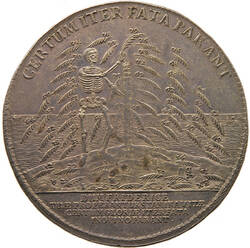This coin is what's known as a "löser". These were especially large and heavy silver coins produced mainly from the output of the mines in the Harz Mountains. For more than a century, from 1574 to 1688, the dukes of Brunswick-Lüneburg and Brunswick-Wolfenbüttel had them minted in weights from one and a half to ten thalers.
Originally, löser coins served as monetary reserves domestically. Then the dukes hit on the idea of using the substantial löser coins to cultivate their own and their family's image and to promote their rule. This löser is such a promotional coin.
It's exceptionally heavy, weighing ten times as much as a thaler. It was issued on the occasion of the death of Duke Johann Friedrich of Brunswick-Lüneburg in 1679.
If you look at the obverse, you'll see his monogram surmounted by a crown: the initials J F within a laurel wreath. The reverse shows a skeleton standing on an island in the sea. The skeleton is plucking the last frond with the number 79 from a palm. Scattered around it are some of the other fronds removed earlier. They're all numbered. The 25 refers to 1625, the year the late duke was born. The scene is an allegorical representation of death. The Latin legend, however, promises the deceased duke a bright future:
"The will of God prepares a secure path. With the thread of your life speedily running out, Friedrich, fate unexpectedly prepares the secure path of fame."
Further Media
- Location & Dating
- Brunswick-Calenberg, 1679
- Material & Technique
- silver, embossed
- Dimenions
- Diameter: 98,5 mm; weight: 256,03 g
- Museum
- Münzkabinett
- Inventory number
- AQB15525
